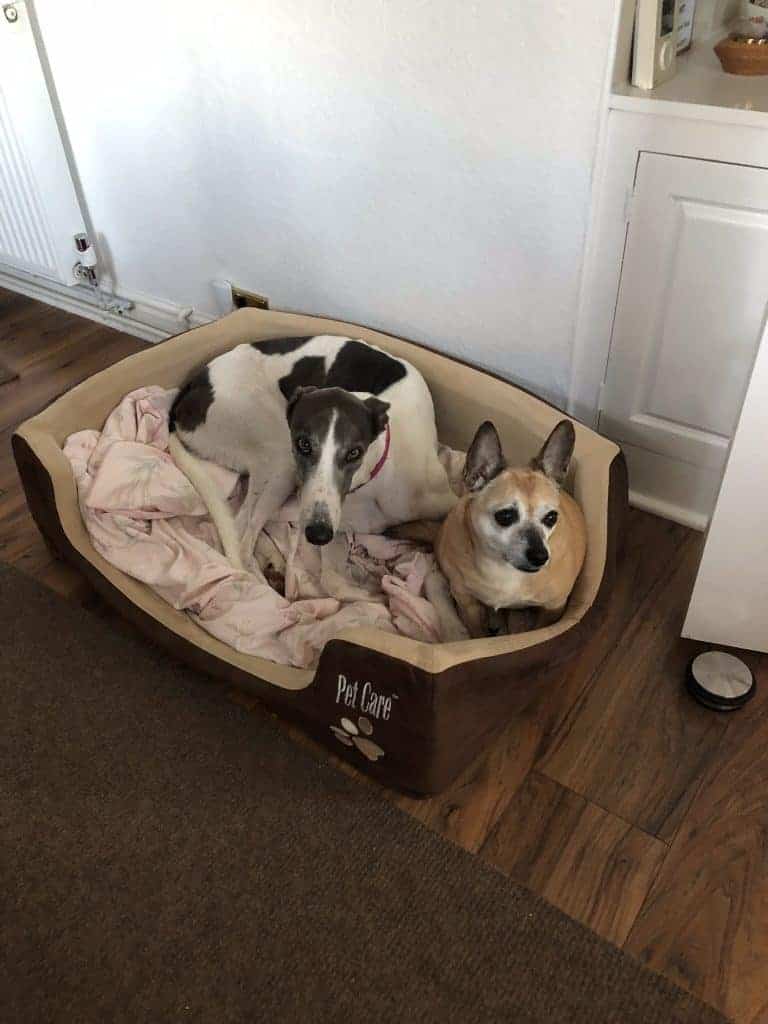Following the end of their racing careers, ex-racing greyhounds typically enter a period of transition, the exact nature of which varies depending on various factors, but often lead to adoption, rehabilitation or early retirement homes.
Transition From Racing
Greyhounds are renowned in the racing industry for speed and agility, but, like all athletes, they also retire. This retirement usually occurs around the age of four or five. Once retired, several things can happen to the ex-racing greyhounds.
- Adoption: Many ex-racing greyhounds are placed in adoption programs, which act as intermediaries that help these dogs find new homes. These programs are intended to make greyhounds pets rather than performers.
- Rehabilitation/Rescue Centers: Dogs that require medical attention or behavioral training will often be sent to rehabilitation or rescue centres. Here, they are given the necessary care until they are ready for adoption.
- Retirement Homes: Some greyhounds are sent to live in retirement homes for dogs, where they can live out the rest of their lives peacefully. These are typically for dogs who aren’t suitable for adoption, often due to medical or age considerations.
Adoption Process of Ex-Racing Greyhounds
The first port of call for many retired greyhounds is typically an adoption group or agency. They will typically assess each dog, taking into account its health and temperament, to determine if, and where, it can be rehomed.
Pre-Adoption Measures
Before greyhounds can be put up for adoption, they usually undergo several medical treatments, including:
- Vaccinations: Like all dogs, greyhounds need to be vaccinated in order to maintain their health.
- Neutering: Typically, greyhounds are neutered before being sent to new homes.
- Dental care: Dental care is often necessary because dogs used for racing are not always provided with the necessary care.
- Other medical exams: General check-ups are performed to evaluate the overall health of the greyhound.
Post-Adoption Support
In addition to the care provided before adoption, there are sometimes resources available to adoptive families, including training advice, veterinary support, and even emotional support to help their new dog adjust to life outside the racetrack.
The Life of the Ex-Racing Greyhounds Post-Adoption
Upon adoption, the life of an ex-racing greyhound can vary greatly depending on their new home environment. However, there are some common elements that many of these dogs experience in this new chapter of their lives:
- A regular schedule: Unlike their days on the track, ex-racing greyhounds in homes usually benefit from a regular and consistent schedule of meals, walks, and rest periods.
- Lots of rest: Surprisingly for many, greyhounds are couch potatoes and love to spend their retirement lounging around the house.
- Socialization: As pets, they will get used to human interaction and possibly other pets in the house. Many discover the joy of toys and play time.
- Training: Some greyhounds need assistance adjusting to common household sights and sounds, such as stairs, mirrors, and household appliances. They may also require basic obedience training.
In conclusion, the life of an ex-racing greyhound takes a significant turn upon retirement. Whether they find a new home, receive treatment at a rescue center, or live out their days in a retirement home, these canines retire from the track to begin a new and often calming stage in their lives.
Advantages of Adopting Ex-Racing Greyhounds
Opting to adopt ex-racing greyhounds can present various benefits for potential new owners as well as for these canines. Here are some reasons why:
- Temperament: Contrary to what their racing background might suggest, greyhounds are generally quiet, gentle, and docile animals, making them excellent pets.
- Exercise requirements: While they can reach high speeds, greyhounds do not require very strenuous exercise – a few short walks and a chance to sprint in a safe, enclosed area are typically enough.
- Size: Greyhounds are a good medium size – not small but not as large as some breeds, making them suitable for many homes.
- Low maintenance: With a short, clean coat, greyhounds do not require significant grooming.
Challenges Faced When Adopting an Ex-Racing Greyhound
Despite the several advantages of bringing an ex-racing greyhound into your home, there are some considerations to be aware of:
- Training: Greyhounds from racing backgrounds may require some additional training. This includes getting used to living inside a home and potentially stairs and glass doors.
- Socialisation: Greyhounds from the racetrack may not be used to other animals or small children, and some may not do well in homes with other pets or young family members.
- Feeding: Racing greyhounds are used to a specific diet, which is often raw and differs from conventional pet food. An adopter may need to work with their vet to transition the greyhound onto a commercial diet in a way that is healthy for the dog.
Comparisons of Adoptions Rates
To better understand how greyhound adoptions compare with other breeds, here is a table illustrating the estimated annual adoption rates:
| Breed | Number of Dogs Adopted |
|---|---|
| Greyhounds | 18,000 |
| Labrador Retrievers | 32,000 |
| German Shepherds | 22,000 |
| Bulldog | 17,000 |
| Beagles | 13,000 |
Source: Annual data reports from various breed-specific rescue organizations
Note: This data reflects adoptions through breed-specific rescue organizations and does not necessarily include other avenues such as local shelters or individual rescues.
Overall, while adoption of ex-racing greyhounds comes with its own set of challenges, they make for excellent and loving pets in the right homes, and their adoption rates reflect their continual popularity even after retirement from the racetrack.
Greyhound Board of Great Britain (GBGB)
The Greyhound Board of Great Britain (GBGB) is the organization that regulates racing and welfare of greyhounds within the greyhound industry in Great Britain.
Specifically speaking about greyhounds’ retirement, here are some of the ways GBGB interacts with and addresses the retiring racer issue:
GBGB Retirement Form
When a greyhound retires from racing at a GBGB track, officials must complete a retirement form indicating where the dog will go after retiring from the sport. This is part of GBGB’s ongoing initiative to track and secure the welfare of greyhounds post-retirement.
GBGB Commitment to Welfare
GBGB has a dedicated commitment to the welfare of greyhounds, both during their racing career and afterwards. This includes:
- GBGB’s ‘Greyhound Commitment’ published in 2018: In this commitment, GBGB promises to put the welfare of greyhounds at the heart of everything they do. Key pledges include a commitment to home as many retiring greyhounds as possible.
- Extensive guidelines and safety measures: GBGB regulates and sets out specific safety measures, including stringent track safety standards and veterinary checks before and after races, to ensure the overall health and safety of racing greyhounds.
GBGB Retirement Scheme
GBGB operates a Greyhound Retirement Scheme where a financial contribution is made at the point of registration towards caring for each greyhound when it retires.
Rehoming Efforts
GBGB works in cooperation with rehoming organizations across the country to ensure that retired greyhounds are given homes where they can live their post-racing lives comfortably. They record and publicly report the data on rehoming numbers.
GBGB Homing Covenants
Owners or trainers in the United Kingdom are required to sign a Homing Covenant under the rules of the GBGB. This requires them to take responsibility for ensuring their greyhound is safely and responsibly rehomed when it finishes racing, a step aimed at safeguarding each dog’s future beyond racing.
In summary, the GBGB plays a crucial role in managing the retirement of racing greyhounds in the UK, and has made significant commitments to secure the welfare of these animals. Its efforts extend from regulation and oversight, to financial support, and cooperation with rehoming charities.
Other Organizations Involved in Greyhound Adoption
A wide array of organizations work tirelessly towards ensuring ex-racing greyhounds find loving homes post-retirement. Here are a few prominent ones:
- The Greyhound Project: This organization advocates for the adoption of ex-racing greyhounds across North America. They provide resources and support for adoption agencies through their magazine and a comprehensive directory.
- Greyhound Pets of America: One of the largest single-breed adoption groups in the country, this organization works to place retired racing greyhounds into homes.
- American Greyhound Council: AGC is a joint initiative of two industry groups that promote the racing, breeding, and adoption of greyhounds in the United States.
Financial Considerations of Greyhound Adoption
Adopting ex-racing greyhounds may seem like a cost-effective affair, but potential adopters should be aware of the financial commitment associated with their care. Here is a break down of potential costs:
Initial Costs:
- Adoption Fee: This can range from about $200–$300. This often includes neutering/spaying, dental cleaning, vaccinations, and microchipping.
- Start-up Supplies: Initial costs for collars, tags, beds, food bowls, and toys can be expected.
Ongoing Costs:
- Food: Greyhounds eat more than smaller breeds. They can also require specific diets due to sensitive stomachs, which can increase food expenses.
- Healthcare: Regular vet check-ups, annual vaccinations, and potential health concerns require budgeting.
- Grooming: As compared to other breeds, greyhound grooming costs are relatively low, but still a consideration.
| Cost Category | Estimated Cost |
|---|---|
| Adoption Fee | $200-$300 |
| Start-up Supplies | $100-$200 |
| Monthly Food Cost | $40-$60 |
| Annual Healthcare | $200-$300 |
| Grooming | $30-$50 |
Special Needs of Ex-Racing Greyhounds
Ex-racing greyhounds come with specific needs due to their upbringing:
- Sensitive Skin: They have very thin skin and short fur. This means they can get cold easily and may require a dog coat in cooler climates.
- Diet: Greyhounds have a more regulated diet when racing, so may have a sensitive stomach when transitioning to commercial pet food.
- Exercise: While not overly active, greyhounds still need one or two chances a day to sprint in a safe, enclosed area.
- Safety: These dogs are not streetwise. They may not be used to traffic or other dangers due to their time on the track and should always be leashed or in a secured area when outside.
In conclusion, while ex-racing greyhounds have unique needs due to their history, they can adapt to pet lives with the right care, patience, and knowledge from their adopters.
Our partner Stadium, Towcester Racecourse, has a comprehensive greyhound retirement program that explains the process of how dogs transition from competition to a more leisurely life.
Frequently Asked Questions About Ex-Racing Greyhounds
Greyhound Adoption Process
Q: How long does it typically take to adopt an ex-racing greyhound?
A: The adoption process for ex-racing greyhounds may vary depending on the organization, location, and availability of dogs. Generally, the process could take anywhere from a few weeks to a few months. Factors affecting the adoption timeline can include waiting for a suitable match, the dog’s decompression period, and preparation like vaccinations or spaying/neutering.
Q: Are ex-racing greyhounds usually house-trained?
A: Ex-racing greyhounds may not be initially house-trained when they enter an adoption program. However, many organizations and foster homes work on house-training the dogs before they get adopted. Greyhounds are intelligent animals and tend to adapt and learn quickly with consistent guidance and positive reinforcement.
Exercise and Physical Needs
Q: Do ex-racing greyhounds require a large living space?
A: Although greyhounds are a larger breed, they do not require a large living space, as they are often quite content with lounging around indoors. They can do well in apartments or smaller homes as long as they have enough space to move comfortably and receive daily walks and opportunities to sprint in a safely enclosed area.
Q: Can I take my ex-racing greyhound to a dog park?
A: While taking an ex-racing greyhound to a dog park can be an enjoyable experience, make sure the park has a secure, fenced area where they can exercise safely without a leash. Greyhounds have strong prey instincts, and if they see something worth chasing, they may take off. Additionally, be cautious introducing them to unknown dogs, as their experience with other breeds might be limited.
Greyhound Compatibility
Q: Are ex-racing greyhounds good with cats?
A: Some ex-racing greyhounds may have strong prey instincts, which could make them less cat-friendly. However, individual greyhounds vary in their friendliness towards cats, and many can adapt to and get along with feline housemates. It’s essential to do a proper introduction and always supervise their interactions initially, keeping in mind that each dog’s compatibility with cats may differ.
Q: Are ex-racing greyhounds good with other dogs?
A: Ex-racing greyhounds are often accustomed to being around other greyhounds during their racing careers. However, their interactions with other dog breeds might be limited. Many greyhounds can quickly adjust to living with other dogs, but it’s vital to make gradual, supervised introductions and monitor their interactions in the early days together.
Training and Socialization
Q: How do I train my ex-racing greyhound?
A: When training an ex-racing greyhound, incorporate positive reinforcement techniques such as praise, petting, or treats. Greyhounds are known to be intelligent and eager to please, but they can also be stubborn at times. Patience and consistency are crucial in achieving successful training. Remember that they may be inexperienced with typical pet commands, so start with basic obedience training and socialization.
Q: Can ex-racing greyhounds participate in dog sports?
A: Yes, ex-racing greyhounds can participate in various dog sports, such as lure coursing, agility, rally obedience, and nose work. Such activities can provide a healthy outlet for their energy, stimulate their minds, and strengthen the bond between the dog and owner. It is essential to understand the physical capabilities and limitations of your greyhound and gradually introduce them to new activities.
General Care and Management
Q: What type of harness or collar should I use for my ex-racing greyhound?
A: Greyhounds have slim heads and necks, making them more prone to slipping out of a standard collar. A Martingale collar or a secure harness is recommended for ex-racing greyhounds, as these options provide extra security and help prevent accidental escapes during walks.
Q: Do ex-racing greyhounds need dental care?
A: Yes, ex-racing greyhounds, like any dog, require dental care to maintain their oral health. Regular teeth brushing, dental chews, and annual professional cleanings are all essential components of keeping their teeth and gums healthy. Some adoption organizations might provide an initial dental cleaning before the dogs are placed in their new homes.
Additional Health Considerations
Q: Do ex-racing greyhounds need to be on heartworm prevention medications?
A: Yes, heartworm prevention is essential for ex-racing greyhounds, just as it is for any dog breed. Heartworms are parasites transmitted through mosquito bites and can cause severe illness or even death. Consult with your veterinarian to determine the appropriate medication and dosage for your greyhound, as well as discuss the frequency of administration.
Q: Are ex-racing greyhounds prone to separation anxiety?
A: Some ex-racing greyhounds might experience separation anxiety, as they are used to being around other dogs and people during their racing careers. Gradually helping them adjust to being alone for short periods can help alleviate this anxiety. Providing interactive toys and creating a comfortable environment while you’re away can also help reduce stress. In more severe cases, working with a professional trainer or your veterinarian to develop a plan for managing separation anxiety may be beneficial.
Greyhound Advocacy
Q: How can I support ex-racing greyhound organizations and advocacy?
A: To support organizations working with ex-racing greyhounds, consider donating funds or supplies, volunteering your time, or spreading awareness about greyhound adoption. Connect with local or national greyhound rescue groups or share information on social media platforms. You may also consider fostering a greyhound before it finds its forever home, or attend events sponsored by rescue organizations to raise funds and promote greyhound welfare.




